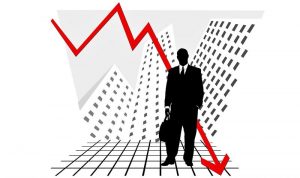Deflation
The term deflation refers to a contraction that occurs in money supply circulating within an economy, and therefore we can say that it is the opposite of inflation. In times of deflation, the purchasing power of the currency and wages are higher than they might otherwise have been. This is different but similar to price deflation, which is a general decline in the level of prices, although the two terms are often confused and used interchangeably.
What is deflation?
It is the fall in product prices over a period of time considered long, excluding price falls in specific sectors.
In effect, deflation makes the nominal costs of capital, labor, goods and services lower than if the money supply were not reduced. While price deflation is often a side effect of monetary deflation, this is not always the case.
Characteristics of deflation
Among the main characteristics that we can mention of deflation, the following are mentioned:
- It occurs when goods and services supply is greater than demand.
- It is a process that causes deterioration in the results of companies.
- It limits the number of workers and investment in goods.
- Demand is diminished by cuts.
- Banks are unable to provide loans.
- Businesses make less profit because of lower prices.
History
The history of deflation dates back to the 19th century, in the United States, when the word “inflation” began to be used to criticize the different governments’ actions that put too much money into circulation, increasing the economy out of control and causing prices to rise. The word was also used to mean a price increase.
Types
There are three types of deflation:
- Historical deflation: it is produced by the increase in production per capita, and where the amount of money is not greatly altered.
- Corrective deflation: occurs when, after a bubble effect on credit due to monetary expansion, economy manages to return to the prices that existed before deflation.
- Inflationary deflation: it occurs after a great monetary expansion, prices try to return to the initial moment, but the central bank prevents it.
Causes of deflation
Monetary deflation can only be caused by a decrease in the money supply or in the different financial instruments redeemable in money. At present, money supply is more influenced by central banks. Periods of deflation most commonly occur after long periods of artificial monetary expansion.
There are two main causes of price deflation. The first is a general increase in the demand for cash savings by consumers and businesses because consumers are uncertain, or because their time preferences for consumption have lengthened. The second cause is a general increase in economic productivity, which increases the supply of goods and increases the purchasing power of incomes.
Consequences
The consequences of deflation are:
- Reduced commercial income because companies must significantly reduce the prices of their products in order to remain competitive. As their prices fall, their incomes begin to fall.
- Wage cuts and layoffs due to falling incomes begin to fall as companies need to find ways to reduce their expenses to reach their bottom line. They can make these cuts by reducing wages and cutting positions.
- Changes in customer spending as they take advantage of substantially lower prices. Initially, consumer spending can increase enormously; however, once businesses start looking for ways to increase profits, consumers who have lost their jobs or who have received wage cuts should also start reducing their spending.
- Reduced credit because financial lenders begin to reduce their lending operations for a variety of reasons.
Advantages of deflation
The advantage of deflation is that in order to combat it, interest rates must be lowered, which causes that currency power to be greater and, in a normal context, citizens with purchasing power consume more and also entrepreneurs without problems tend to increase their investments.
Disadvantages
- It produces financial activity
- It increases the real burden of interest on debtors.
- There is an excess of supply and an insufficiency in demand.
- Banks cannot lend for production.
Examples
- In Japan, prices began to fall several years ago and has damaged the country’s security over the generation of wealth. Businesses have been squeezed, prices have fallen and people with stable jobs have experienced a sense of enrichment, but for others it has produced high levels of insecurity.
- In Brazil, falls in electricity, transport and food prices have been the biggest deflation in history and thanks to this, consumers are able to purchase more goods and services.
- In Spain, although it is considered that many of the products and services will fall, the environment is still marked by a high rate of unemployment and loss of purchasing power so buying remains very complicated. One of the examples of products that have suffered a great deflation has been oil.
How to cite this article?
Briceño V., Gabriela. (2019). Deflation. Recovered on 23 February, 2024, de Euston96: https://www.euston96.com/en/deflation/










